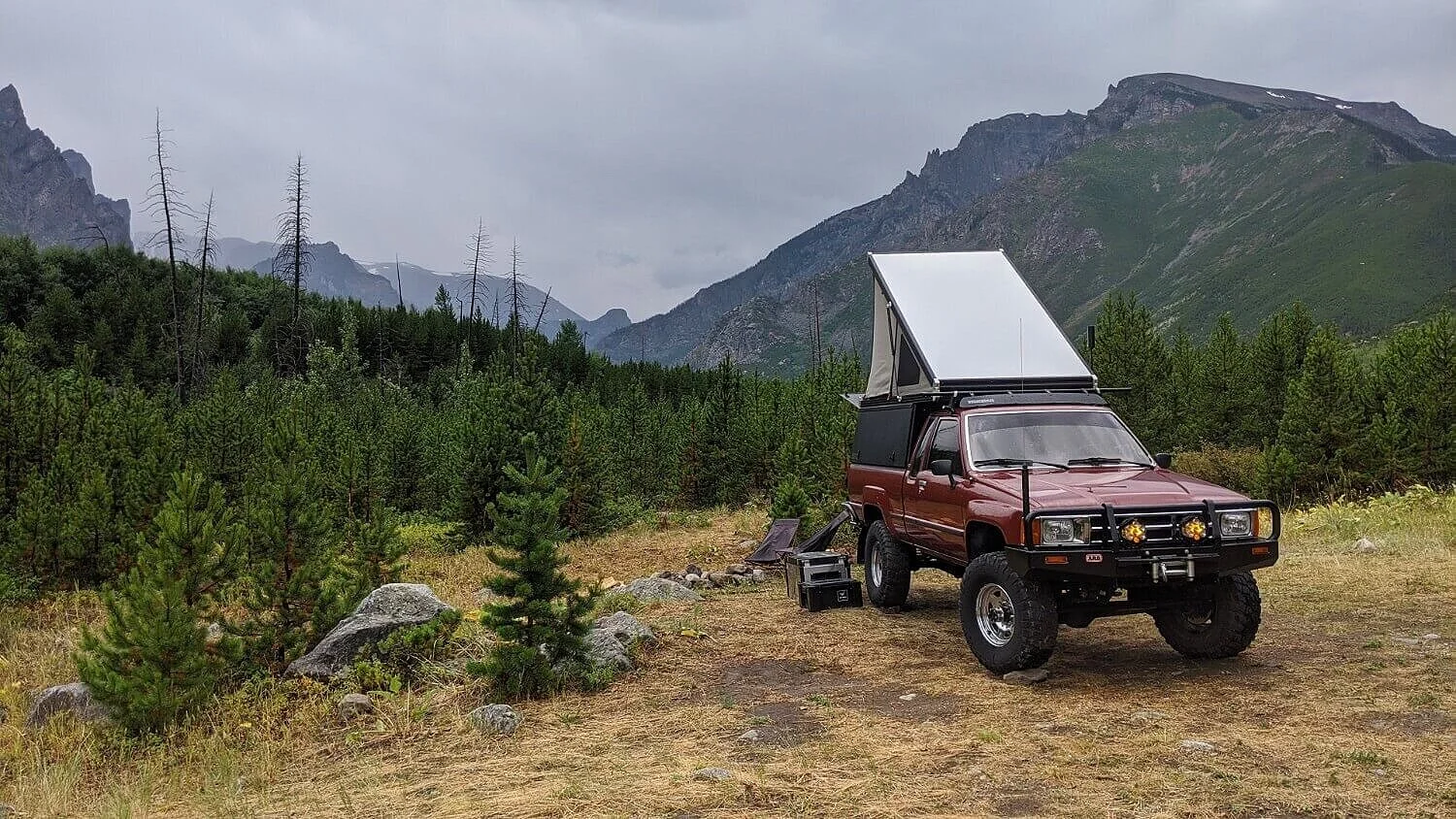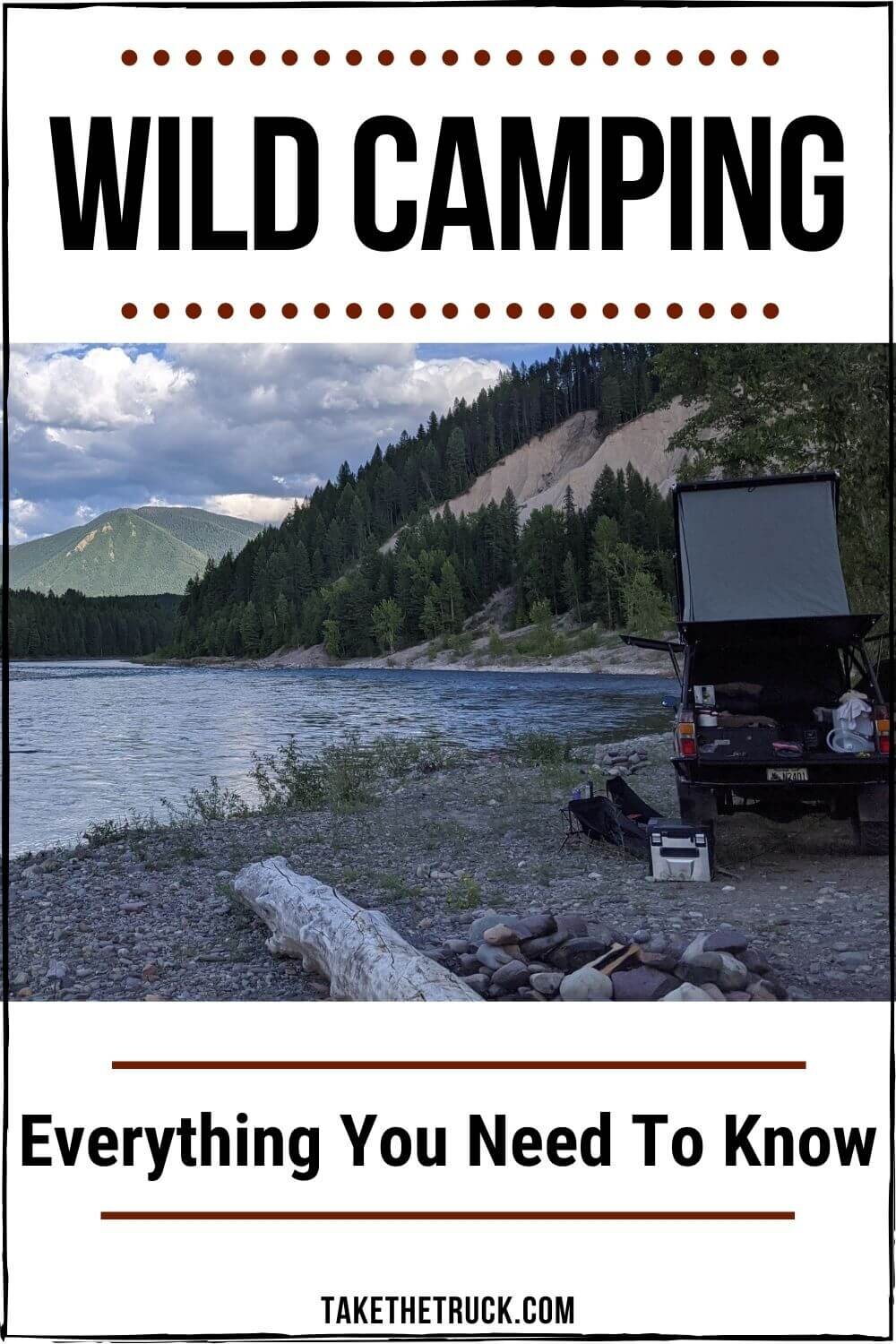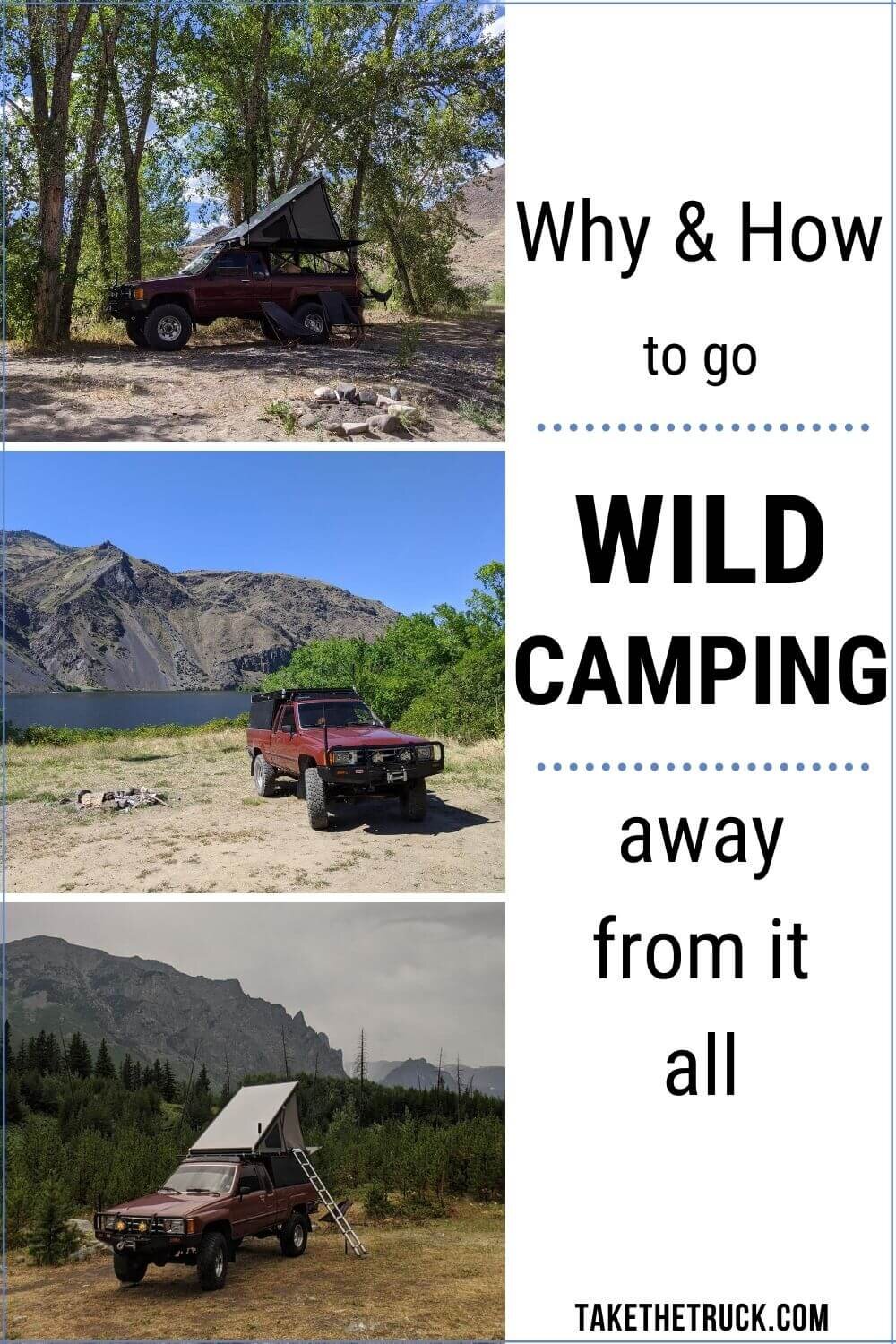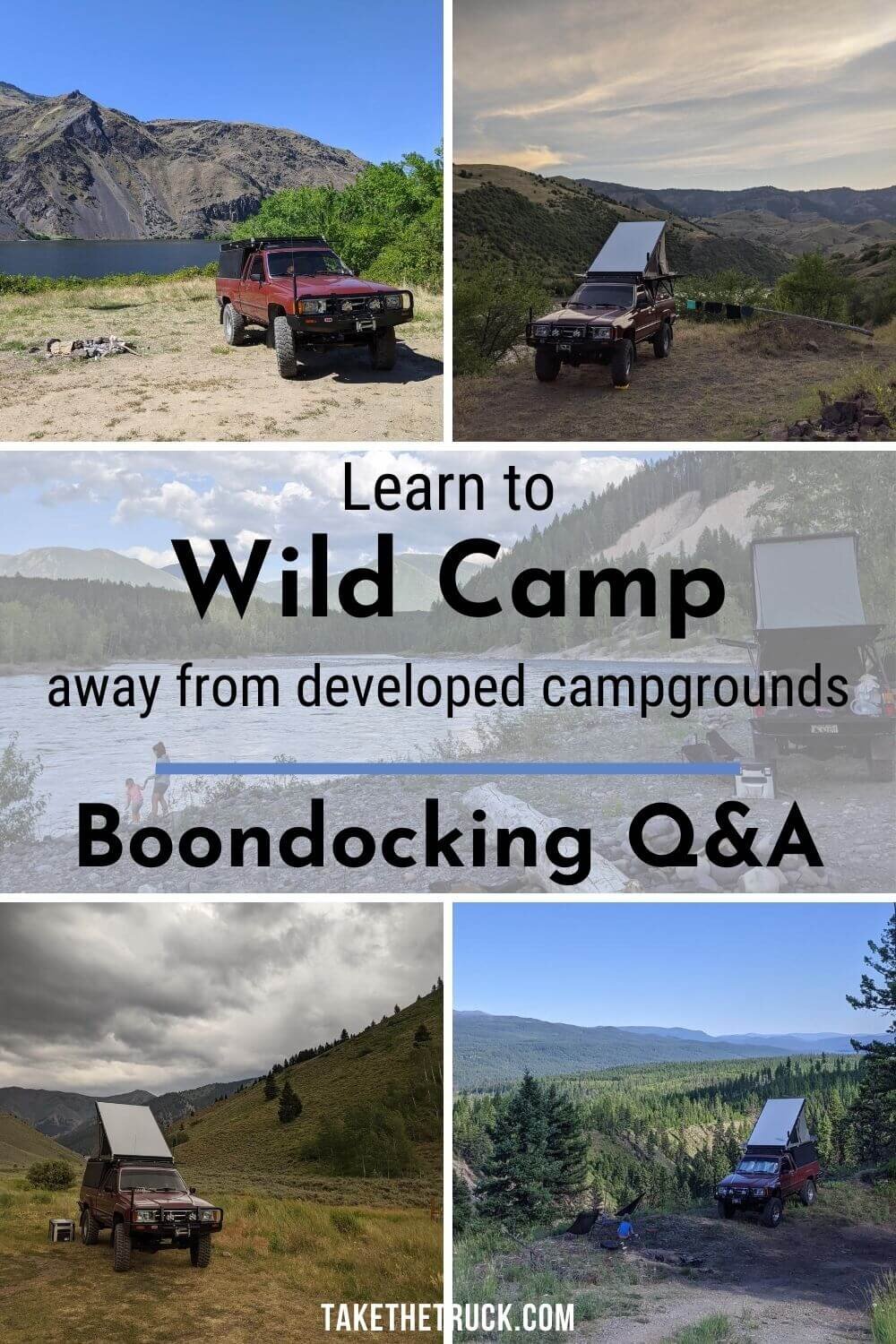Start Wild Camping Like a Pro [16 Boondocking Questions Answered]
Have you heard the terms boondocking, dry camping, primitive camping, off grid camping, wild camping, dispersed camping? They essentially all refer to the same thing - camping with no hookups!
No matter what you want to call it, that’s what this post is all about! There’s a ton of information here, so scan through and check out the parts that apply to you!
*(This post contains affiliate links. This means we may receive a small commission, at no additional cost to you, if you make a purchase through a link. See our full disclosure.)
So, what exactly is wild camping or dry camping, etc?
When you go boondocking or wild camping, you are completely dependent on your own rig and equipment - whether that be an RV with huge holding tanks, a campervan, a truck bed camper, or a rock’n tent setup.
When wild camping away from developed campgrounds you have to be prepared to be self-sufficient! No water hookups, no electric to plug in to, no dump stations, sewer, or bathhouses to make use of!
Why go wild camping?
So you might be thinking, that sounds really hard, kinda terrible, and not very relaxing. We hear ya! But once you try boondocking, you’ll quickly see the benefits! Here’s why:
You do all the work to load up everything needed for a weekend of camping. The work is finally done! So you drive the 30 minutes to your local campground, pay, and check in to the spot you had to reserve last month. You get all set up, whether that’s popping up your camper, setting up a tent, or opening your slide out, grab your favorite camp chair and drink, and sit down. What do you see? Feel? Hear? Smell?
Most likely, you just paid to “get away from it all” so that you could surround yourself with strangers and their large RV slide outs up in your space, hear the sounds of their conversations or music or generators, feel asphalt under your feet, and smell their dinner (hopefully that’s all you smell from your camping neighbors!).
Personally, that isn’t our cup of tea. Here’s what is...
Drive (yes, probably a little further) to a nearby remote and secluded spot, where you can typically pull in at any time and find a totally free campsite waiting for you. You’ll see trees, hopefully a creek or river, hear the sounds of water rushing and birds overhead, and feel grass and dirt under your feet. And you are alone!
We think you’ll find that that’s worth the effort it takes to get everything ready for an off grid camping trip. It’s rejuvenating and life-giving. And, it’s free!
Okay, maybe I’m interested. But wild camping still sounds really difficult!
There’s no denying that boondocking or camping off grid can be difficult at first.
For many, you have to learn and practice a totally new skill set. It does take extra preparation, forethought, and practice. A few special pieces of gear might be in order to remain comfortable when primitive camping, and you might even have a couple challenging trips at first.
But if you can become practiced and proficient at wild camping, new doors will open! You’ll find gorgeous soul-filling spots to camp. You’ll be able to go to festivals and expos where the only camping available is dry camping. Camping in free spots means no check in and check out times, so you won’t feel rushed. And if you camp often, you’ll save a ton of money too!
So let's go over some of the most common questions and concerns we hear about wild camping. And if we happen to skip your burning question, drop us a comment below!
Where can I legally boondock or dry camp?
One of the initial hurdles to wild camping is finding places you can legally camp for free, and ensuring they’re worth the effort to spend your time there unplugged.
We’ve got a handful of spots like that within a couple hours of our house, and it has taken some time to find them. And then we’ve found dozens and dozens of places like that across the country during our travels.
We’ve also stayed in free camping spots that are trashed or are no more than a crowded grassy parking lot - much like the RV parks we avoid (except free).
Finding free camping usually does take time and practice, and a little extra effort as compared to reserving a spot at the local campground.
But worry not! We’ve got an entire post to help you easily find free and legal camping in the United States:
It contains everything you’ll need to know to find free camping, as well as things you should be looking for or paying attention to when searching.
Is it safe to go dry camping away from public campgrounds? What if I need something?
Lots of fellow campers are concerned about camping security and safety when wild camping away from civilization, and they wonder if boondocking is safe. Our short answer is - YES - it’s safe!
But because we know a simple one word answer won’t do in subsiding your concerns about the safety of wild camping, we’ve got an entire post on this topic!
This is a super thorough guide, including general safety tips, security measures, emergency avoidance and preparedness, as well as specific products to help you feel feel safer and more secure while boondocking.
So, yes, wild camping is safe - assuming you use your noggin, pay attention to your gut and your surroundings, and have the right gear.
When is it best to go boondocking?
No doubt, there’s a certain temperature range that makes wild camping more enjoyable, because being off grid does make climate control more challenging.
Spring and Fall Wild Camping:
Because of this, it's common to stick to wild camping during the spring and fall months, largely depending on where you live.
Spring and fall camping usually means sleep comes easier as the evenings cool down, days are more temperate, and you don’t typically get covered in sweat (more sweat means more showers which means more water use ~ no bueno).
Summer Wild Camping:
If it’s sweaty hot all day and into the evening, and remains warm throughout the night, wild camping becomes less appealing. But being able to swim adds a lot of fun!
We have a post full of great tips on staying cool when camping in the heat, and is written with camping off-grid in mind.
Cold Weather Wild Camping:
Wild camping in the winter when it’s cold outside comes with it’s own set of challenges, but it's certainly doable, and can be really fun!
Head over to this post for a few tips on staying warm when winter camping:
Winter Truck Camping - A Cold Weather Camping Guide (these tips can apply to tent or vehicle camping of any kind!)
So while certain seasons and temperatures make primitive camping more challenging, there are a few simple things you can do to stretch your wild camping season without sacrificing much comfort.
How do you use the bathroom when camping off grid?
This is the question that almost everyone likely wants to ask (and some do) but many may be too embarrassed to.
As truck bed campers with no toilet on board, we do our business outside. We have a Pstyle so we can all stand up to pee, which has been a lifesaver for the girls in our family when camping, traveling, and hiking.
Just be sure to practice using your “female urination device” at home, because as a girl it does not feel natural to pee standing up. And dripping pee all over yourself is a real downer. There are quite a few options out there, if you’re interested!
Check out available “FUDs”* and find one that’s right for you
But enough about pee. I’m pretty sure you’re most curious about what to do with #2.
We’ve written an entire guide all about wild camping and boondocking bathroom options so you don’t have to ask!
Complete Guide to Using The Bathroom While Camping discussing everything from cat holes, to wag bags, to the portable camping toilets!
OR check out our post detailing The Best Portable Camping Toilets
How would I have enough water to do everything I need to do?
Running out of water when boondocking or wild camping is a real deal breaker.
Here’s what you need to know:
Have large enough water containers, and ensure they’re completely full when heading out
Always be conscious of your water usage and learn to conserve
Know how and where to get more water when needed
And of course, we can help you with each of these things:
Water Container:
Here’s a post all about the water container we used and liked for our original truck camping setup - the Roadshower - although for most campers that may not be the ideal solution.
And this is a great DIY option Patrick came up with when we switched to our Go Fast Camper. It can be pressurized or gravity fed, and serves as both a water container and DIY camping shower.
The tried and true blue Aquatainer is a simple, cheap, and practical water container that will work for most tent or vehicle campers. And be sure to bring reusable water bottles (already filled, of course), and even an extra couple gallon jugs of water if you’re nervous you’ll run out.
Water Conservation:
Becoming accustomed to using less water might be one of the more challenging aspects of learning to successfully boondock. The smaller the water container and the more people it supports, the more careful and thoughtful you’ll have to be!
This post details dozens of ideas on how to conserve water when wild camping:
Refilling Your Water Container if Needed:
If you’re primitive camping for more than a weekend, you’ll need a plan for refilling your water containers. There are plenty of places to get free or cheap access to drinking water, and they’re outlined in the Water Conservation post linked to above.
We also recommend carrying a quality water filter that you can trust. This will allow you to pull water from most any stream, river, or creek to refill your water container without having to break camp. After a few negative experiences with cheaper water purifiers, we highly recommend the one we finally landed on:
how will we be able to shower and stay clean when wild camping?
First, you’ll have to wrap your head around the fact that showering and staying clean are two different things!
There are so many ways to get clean without showering under hot running water for 10 minutes.
So whether you’re boondocking in an RV with 50 gallons of water, or truck camping with 7 gallons of water, you can say goodbye to your idea of the perfect shower like you take at home.
If you’re still with me, our post in the link below outlines multiple ways to stay clean when dry camping or wild camping with a limited water supply:
What about cooking without hookups?
No, you won’t be able to cook using your pressure cooker or your microwave when camping off grid, but your propane stove will become your best friend!
Your propane stove is your heat source for everything you need to cook. Warming up food? Propane stove. Making toast? Propane stove. Need hot water for something? Propane stove. Cooking pizza? Dutch oven on your propane stove.
Before going boondocking, the key is to make sure your propane is full enough, as you will be dependent on it! And over time, you’ll get an idea of how long your tank will last.
If you have a setup that requires the small propane canisters, always have a backup handy.
You might run into a few snags as you learn, but mostly, it's pretty easy to come up with simple camping meals that require little more than heat from your stove.
Here’s a couple posts with a whole bunch of easy camping meal ideas to get you moving in the right direction:
And here’s our guide detailing how to set up a basic camp kitchen:
Plus there’s always cooking over the campfire - if they’re permitted in the area you’ll be camping in. Check out our in-depth guide on How to Build a Campfire for a ton of helpful info on ways setup a campfire cooking (plus a ton of other helpful tips on building campfires).
how Will I keep food cold if I can’t plug My Fridge into electricity?
If you go camping just a few times a year or are just getting started, you likely already have a decent cooler to keep your food cold.
However! If you camp often and can afford it, we’d highly recommend getting a camping fridge. Our camping fridge has been one of our favorite pieces of gear for truck camping, and helps make our camp kitchen feel like a real kitchen.
Here’s how to pick a great camping fridge:
How about charging my cell phone, running my camping fridge, using lights, etc?
Though it’s not quite as straightforward and easy as simply plugging into “shore power” at a developed campground, there are several ways to have a portable camping power supply that will meet your basic power needs while boondocking.
Camping power supplies vary in complexity based on how great your power needs are and your camping style (weekend camping vs long-term travel). They can be as simple as using an inexpensive AC power inverter in your vehicle's 12v power outlet, or as complex as a complete dual battery setup.
Don’t feel overwhelmed! Just check out our Camping Power Series, where we walk you through the process of selecting a camping power supply that’s right for your needs:
While boondocking, the key is to always be mindful of your power use, and intentionally purchase camping gear with low power consumption when possible.
What about having dependable cell service and wifi?
Yeah, this is a tough one.
Plenty of these picturesque free campsites we’re talking about don’t come with complimentary wifi, or even cell service for that matter! So this is where you have to assess your personal need for this connection.
If you can - we would strongly encourage you to take advantage of being disconnected from “digital life”, and use this opportunity to enjoy your surroundings and family.
If you need service in order to have your GPS help you get around or because you feel like you’d need to make a call in case of an emergency, here’s what we’d recommend:
Download maps ahead of time - most mapping and GPS apps, including Google Maps, allow you to download routes and maps in advance and store them locally on your phone
Always tell someone where you’re going - give them GPS coordinates or detailed directions, and let them know for how long you expect to be gone - just remember to follow up with them when you get back to cell service.
Be mindful of the last point you have service going into a remote boondocking location, in case you need to drive or walk back to phone for help
Know the general direction of the nearest medical center from your boondocking location
Now, If you need service to be able to work remotely, we feel ya!
During our travels, there have certainly been times that our campsite was dictated by whether or not we’d be able to work remotely. Here are some things you can do to improve your odds of a successful work-camping spot:
If you travel as a couple, having cell phone plans with two different carriers gives you a better chance at having usable service while boondocking - we use a combination of AT&T and Google Fi (which uses T-mobile, Sprint, and US Cellular towers) and have been very happy with the flexibility and coverage this combination offers.
Read reviews on freecampsites.net before going. People that contribute to this boondocking resource will often give some insight into cell service availability
Invest in a Cell Signal Booster - these devices do not create service where there is none, but will often improve an otherwise weak/unusable signal to one that is usable. However, the ones that work well are a significant investment - for serious road warriors we recommend the Wi-Boost Drive Reach* with OTR Antenna*, and here’s our post telling exactly why we recommend it.
At the end of the day, if you absolutely need a signal while boondocking and your intended site doesn’t have any, you can always try another campsite!
What if I Need To Wash Clothes While Wild Camping?
If you think you might need a camping washing machine, we’ve had great experience with the Scrubba Wash Bag.
You can’t do a lot of laundry per load of course, but it is compact, uses very little water, and it gets clothes really clean.
You can check out our post all about why we like it and how we use it:
But we have kids! How would we Go wild camping with kids?
Anything with kids along does add some work, but if you’re already somewhat practiced at camping with kids, wild camping with kids isn’t that much more of a stretch!
We’ve already talked about the difficulty of keeping your camping rig at the right temperature during summer or winter camping in some parts of the country, and if you have a baby, you might just avoid camping during those seasons/temperatures. Trying to have your baby sleep when you know the temperature just isn’t right will likely lead to a weekend of restless nights for the parents.
But other than that, boondocking with kids is pretty much the same as camping with kids at developed campgrounds (but better, of course).
Entertainment:
As far as entertainment, don’t worry that your kids won’t be able to go to the campground playground you might be used to. Rather, bring a few toys that encourage outdoor play and let them get creative.
We always bring nesting cups because they can be used in so many different ways, and maybe a handful of small plastic toys (like an animal set or little people or something). Our daughter plays with sticks, plays in the water (bring life vests!), makes “recipes” using the nesting cups, hikes with us, gathers leaves and pretty rocks, etc etc etc.
And we also bring some books and a few favorite down time activities like coloring books or a small puzzle, as well as a couple “together” things like card games.
We are continually surprised by how little she uses/needs from home, and even though we bring less each time, we still always have more than needed. And we think you’ll find the same to be true when wild camping with your kids too.
Staying Clean:
Your kids don’t need baths every day. They will be okay to skip it. Yes, even if they are actually dirty from camping. Use a small amount of water (heat it up if needed) and spot clean. Face, hands, feet. Baby wipes can help.
Bathroom:
You’ll have to teach your kiddo how to use the bathroom outside. For some this is no big deal, and for others it is rather difficult (same for adults!).
This post gives tips on bathroom use when wild camping for adults and kids if you missed it above:
What else would I need to know before going wild camping or boondocking?
Leave no trace - Pack it in, pack it out!
There are no trash services or dumpsters at most free camping sites across the country. And unfortunately some people do leave their garbage all over the place, leading to more and more free camping sites being shut down, as they become too expensive to maintain or the toll on the environment becomes too great.
So please don’t do that. Know that whatever you bring to camp, you’ll need to take back home with you.
We’ve gotten into the habit of eliminating any possible recyclables or garbage we can BEFORE packing up to go camping, whether weekend camping or traveling. For example, we take most pre-packaged food out of the cardboard box. This saves a ton of space but also results in less trash/recycling at our campsite.
Outside of our own needed trash bags, we also keep a few extra trash bags and a few pairs of disposable gloves for cleaning up trash others have left behind.
What other questions do you have about wild camping?
If there’s anything we missed or glossed over, please leave a comment below and we’ll do our best to get it answered!
We hope this post on all things wild camping and boondocking has given you the confidence to get out there and try it!
The pros far outweigh the cons, especially once you’ve gotten over the primitive camping learning curve.
Please SUBSCRIBE for new blog posts to be sent right to your inbox, and thanks for reading!
Related Posts:
Pin Me To Your Camping Board!
We’d appreciate a share!
















